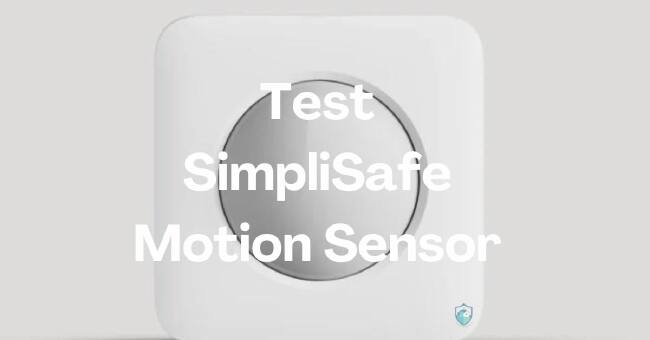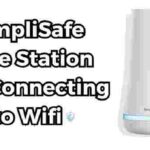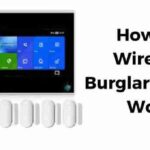Table of Contents
Have you ever wondered how to test SimpliSafe motion sensor if it is working correctly? Yes, I found myself preoccupied with that question after our home was burglarized last year.
The break-in happened during the day while my family was out. I thought our system would detect the intruders, but the motion sensors never went off.
That’s when I realized testing them regularly is critical.
Testing your motion sensors is a crucial step to ensure they are detecting movement and triggering alarms as expected.
If you skip sensor testing, you could miss signs of a faulty device and have gaps in your home’s security coverage.
Don’t worry – testing your SimpliSafe motion sensors is easy to do yourself. In this guide, I’ll walk through all the steps and best practices for performing a thorough motion sensor test. You’ll learn:
- How SimpliSafe motion sensors work to detect movement
- Tips for optimizing your sensor’s settings and placement
- Troubleshooting guides if your sensor encounters any issues
- When and how often you should test your motion sensor
With the right testing routine, you can keep your SimpliSafe motion sensors in peak condition.
Let’s get started!
Understanding How the SimpliSafe Motion Sensor Works
To test a motion sensor properly, it helps to first understand what’s going on inside these clever little devices.
SimpliSafe motion sensors use passive infrared (PIR) sensor technology to detect motion.
This means they monitor infrared energy emitted by human bodies to sense movement and temperature changes.
Here are some key facts about how PIR motion sensors work:
- They have an infrared sensor consisting of two pyroelectric sensors that detect levels of infrared radiation
- When a person moves within the detection zone, the amount of infrared radiation on the two sensors changes
- This difference triggers the motion sensor to send a signal to the SimpliSafe app triggering an alert
- PIR sensors have a specific detection pattern and field of view where they can pick up movement
Some SimpliSafe motion sensors also contain a microwave sensor or use microwave technology to detect motion.
This works similarly but uses microwave pulses and checks for changes in the reflection of these pulses when a person moves.
The sensitivity, size of the detection zone, and other settings can be adjusted in the SimpliSafe app.
Getting the right settings tailored to your space is key for properly testing motion detection.
Some key specs and features of SimpliSafe motion sensors include:
- Detection range of up to 50 ft
- 120 degree field of view
- PIR and microwave dual motion detection
- Adjustable motion sensitivity
- Wireless connectivity with WiFi mesh network
- Battery powered with up to 5 year battery life
- Motion detection LED indicator
- Operating temperatures between 14°F to 104°F
Now that you understand the basics of how SimpliSafe motion sensors work, let’s go over how to test them effectively.
Preparing for Your Motion Sensor Test
Before testing, it’s important to make sure your SimpliSafe equipment is set up properly:
Charge the motion sensor battery
Ensure your motion sensor has a full battery charge. Batteries last 2-5 years, but you don’t want low battery to affect your test results. The LED light on the sensor will blink red when the battery is low.
Download the SimpliSafe app
The SimpliSafe app for iOS and Android allows you to adjust settings and view motion sensor activity in real-time. This is crucial for testing.
Connect the sensor to WiFi
Check that your motion sensor is connected to your WiFi network in the SimpliSafe app. This allows it to communicate with the base station.
Enable test mode
In the SimpliSafe app, you can enable a Test Mode that makes the motion sensor more sensitive for testing purposes. Instructions are in the app.
With those preparations complete, you’re ready to start testing!
How To Test SimpliSafe Motion Sensor: Performing a Walk Test
The best way to test your SimpliSafe motion sensor is to perform a walk test. This involves walking through the sensor’s detection zone and observing how it responds.
Follow these steps to perform a walk test:
- Step 1. Activate test mode
- Step 2. Walk through the detection area
- Step 3. Observe the motion sensor LED
- Step 4. Check the app for alerts
- Step 5. Test the far range limits
- Step 6. Repeat for completeness
1. Activate test mode
If available, turn on Test Mode in the SimpliSafe app. This makes the sensor extra sensitive so you can more easily confirm motion detection.
2. Walk through the detection area
Slowly walk through the area where you expect the sensor to detect motion. Walk in different directions and paths to test the full detection pattern.
3. Observe the motion sensor LED
Watch the small LED light on the motion sensor. It should blink when motion is detected during your walk test.
4. Check the app for alerts
The SimpliSafe app should push notifications to your phone each time motion is detected.
5. Test the far range limits
Verify the sensor works at the maximum advertised 50 foot detection range by walking at the furthest limit of its detection zone.
6. Repeat for completeness
Conduct a few test walks at different times of day. This helps confirm consistent motion detection performance.
Pay attention to any gaps in motion detection during your walk tests. Make a note of dead zones or spots where the sensor misses movement so you can adjust its placement later on.
It’s a good idea to record a walk test on video so you can review motion detection consistency. Now let’s go over adjusting settings.
Adjusting Your Motion Sensor Settings
If you notice certain issues during walk testing, adjusting your SimpliSafe motion sensor settings may help:
Sensitivity
If the sensor misses movement or has false alarms, tweak motion sensitivity in the app. Higher sensitivity detects the smallest motions but can cause false alarms.
Time delays
Adjust the time delay before sending push notifications. This prevents excessive alerts if you repeatedly trigger motion.
Inactive alerts
Enabled inactive alerts if you want notifications when a sensor detects no movement after an expected interval. Helpful for monitoring infants or elderly.
Use walk testing to find the right balance of settings that provide reliable motion detection without excessive false alarms.
Troubleshooting Common Motion Sensor Issues
Walk testing often reveals issues that you can troubleshoot:
Battery and connectivity
If your sensor has no response, first check the battery level and WiFi connection. Power cycle the sensor and pair it again if needed.
No motion alerts
If the LED activates but you get no app notifications, re-pair the sensor and check WiFi strength in that location.
False alarms
Frequent false alarms are often due to high sensitivity. Lower it incrementally to reduce false triggers while still detecting real motion.
Limited range
If range seems shorter than 50 feet, move the sensor to a central location in the room with clear line of sight.
These are some quick troubleshooting tips. Always start with a battery check and connectivity test to rule those out. Adjust settings and placement to refine performance.
Now let’s go over optimal motion sensor placement and setup best practices.
Motion Sensor Placement and Optimization
Proper motion sensor positioning is crucial for reliable motion detection. Follow these tips:
Height
Mount the sensor about 7 feet off the ground looking down. This gives the best angle to detect human motion.
Location
Place it in a central area with an unobstructed view of the whole room. Avoid corners.
Face the most likely entry points
Aim the sensor toward doorways or windows where intruders would enter.
Avoid temperature swings
Prevent false alarms by avoiding placement near HVAC vents or heat sources which can affect readings.
Consider pets
If you have pets, place the sensor above their reach to prevent false triggers as they move around.
Minimize obstructions
Eliminate objects like plants or furniture in the sensor’s line of sight that can block motion detection.
Experiment with different placements during your walk tests to determine the optimal positioning. A few adjustments can often make a big difference in detection performance!
And those are the basics of testing and optimizing your SimpliSafe motion sensors!
FAQs
How Do You Check The Sensor Status On SimpliSafe?
You can check the status of your SimpliSafe sensors in a few ways:
- Open the SimpliSafe app and select the “Sensors” tab – this will display a list of all your sensors and show if they are online/active or offline. Green means online, while red is offline.
- In the app, tap on the individual sensor to see more details like battery level, signal strength, when motion was last detected, etc.
- On the SimpliSafe keypad, look for the sensor status lights. A green light means the sensor is online and active.
- Perform a walk test and observe if the sensor’s LED lights up when you walk by. No light could mean an issue with that sensor.
- Listen for chime notifications from the SimpliSafe base station when sensors detect motion during a walk test.
Regularly checking sensor status this way ensures your SimpliSafe system is working properly and detects intruders reliably.
How Can I Tell If A Motion Sensor Is Working?
There are a few quick ways to test if your SimpliSafe motion sensor is working properly:
- Wave your hand in front of the sensor and look for the small LED light to flash. This indicates it is detecting motion.
- Walk slowly across the sensor’s detection area and watch for the LED to light up as it sees your movement.
- Check the SimpliSafe app after doing a walk test to see if motion alerts were triggered.
- Listen for chime sounds from the SimpliSafe base station when motion is detected.
- Activate the sensor’s Test Mode in the SimpliSafe app. This makes it extra sensitive so motion is easier to detect.
- Verify the sensor has a strong WiFi connection in the SimpliSafe app to ensure reliable communication.
If the LED light activates from motion but you receive no app alerts, try re-pairing the sensor or checking its WiFi connection strength. Consistent LED motion response means the sensor itself is working correctly.
How Do I Activate SimpliSafe Motion Sensor?
Activating a new SimpliSafe motion sensor for the first time is easy:
- Create a SimpliSafe account if you don’t have one already and make sure the base station is online.
- Power on the motion sensor by inserting the included batteries.
- In the SimpliSafe mobile app, tap “Add New Device” and select the motion sensor from the list of device types.
- Follow the in-app instructions to press the pairing button on the back of the sensor when prompted. This pairs it to your SimpliSafe system.
- After successfully pairing, name the sensor and select the room it is located in within the app.
- Mount the sensor in the desired location on the wall using the included mounting tools and hardware.
- Check that the sensor status light pulses green in the app and perform a walk test to confirm motion detection.
The sensor will now send push notifications to your phone whenever motion events occur. Adjust sensitivity and other settings in the app as needed. Adding the sensor to your WiFi expands its wireless range.
How Do I Put SimpliSafe In Test Mode?
Putting your SimpliSafe system into Test Mode allows you to test sensors without triggering real alarms:
- Open the SimpliSafe app and log into your account.
- Tap on the hamburger menu icon in the upper left corner.
- Select the “Sensors” option.
- Tap the gear icon in the upper right to access settings.
- Scroll down and toggle the “Test Mode” switch on.
- Test mode will remain active for 12 hours. The app will display alerts when sensors detect activity to verify they are working.
- Real alarms will not sound while Test Mode is enabled.
- When testing is complete, return to sensor settings and turn Test Mode off to re-activate real monitoring.
Test Mode is useful for validating proper operation during installation or troubleshooting issues with motion detection. Just don’t forget to turn it off when done!
How Far Do SimpliSafe Sensors Work?
SimpliSafe motion sensors have an effective wireless range of about 50 feet in optimal conditions. This allows flexibility for mounting them in different areas of your home.
Some factors that can affect the functional range include:
- Obstructions – Walls, floors, and furnishings can interfere with radio signals.
- Building materials – Metal structures and concrete block more wireless signals.
- WiFi strength – Weaker WiFi at the sensor location decreases range.
- Battery level – Low batteries may decrease the effective wireless range.
- Antenna orientation – Pointing the sensor’s antenna toward the SimpliSafe base station improves reception.
- Environmental interference – Other wireless signals and electronics can cause interference.
Ideally position the SimpliSafe base station centrally in your home for best coverage. Strategic sensor placement in line of sight also maximizes their wireless range performance.
Does SimpliSafe Work Without Power?
SimpliSafe systems are designed with battery backup capabilities to keep protecting your home even during power outages. Here’s how it works if the power goes out:
- The SimpliSafe base station has a 24 hour backup battery to maintain connectivity.
- All SimpliSafe sensors run solely on battery power with 2-5 year battery life. They continue functioning.
- Any hardwired components like alarm sirens also have built-in battery backups that last around 8 hours.
- As long as the base station has cellular signal during an outage, it can still communicate with the monitoring center if an alarm is triggered.
- Without power, the SimpliSafe system will operate in cellular mode only since WiFi requires your home router. Range may be slightly reduced.
- When power is restored, SimpliSafe will resume normal operation automatically.
So in summary, your SimpliSafe security system is designed to provide continuous monitoring even in a power outage until electricity is restored. Just make sure to check the backup battery levels occasionally.
How Many Sensors Can SimpliSafe Handle?
The SimpliSafe system can support up to 41 wireless sensors and devices combined. This capacity allows you to scale up your system as needed.
Some of the sensors and devices that count toward the 41 device limit include:
- Motion sensors
- Entry sensors for doors/windows
- Smoke detectors
- CO detectors
- Flood sensors
- Glass break sensors
- Panic buttons
- Keypads
- Key fobs
SimpliSafe uses a proprietary wireless mesh network called SimpliSafe Signal. This helps extend the range so you can place sensors in more areas of your home.
Each base station provides the full 41 device capacity. If you exceed that, you would need to add an additional base station which allows connecting up to 82 devices between the two base stations.
How Do SimpliSafe Sensors Communicate?
SimpliSafe sensors use a proprietary wireless mesh network protocol called SimpliSafe Signal to communicate with the base station. Here is how it works:
- Each sensor contains a built-in radio transmitter and receiver using 900MHz frequency.
- Sensors broadcast encrypted data packets over this wireless network to the base station.
- The base station re-transmits packets to extend the range creating a mesh network.
- Sensors can pass packets through each other to route data if needed.
- The base station connects to your WiFi network, allowing remote access via the SimpliSafe app.
- If WiFi is down, the base has a cellular radio for backup to talk to the monitoring center.
This wireless mesh network with redundancy provides reliable communication between all sensors, base station, and app. It operates on reserved 900MHz frequency to avoid interference from your WiFi network.
Recap
Testing your motion sensors is an essential step to ensure your SimpliSafe system detects intruders reliably.
In this guide, you learned:
- How PIR and microwave motion sensors work to detect movement
- Preparation steps like charging batteries and enabling test mode
- How to conduct a walk test to verify detection
- Adjusting settings like sensitivity to improve performance
- Troubleshooting issues like false alarms or connectivity
- Tips for ideal motion sensor placement in your home
The key is regularly performing thorough walk tests to validate motion detection and fine-tune your sensor. Proper testing gives you confidence your SimpliSafe system is working 24/7.
Conclusion
Regular motion sensor testing gives you confidence your SimpliSafe system is working 24/7.
Simply follow the walk test process and adjust settings as needed. Also check placement to optimize detection coverage.
By taking a few minutes per month to validate your sensors, you can identify any issues and maximize burglar-catching performance. Your home’s security depends on it.





Pingback: How To Arm And Disarm SimpliSafe: 5 Steps -
Pingback: SimpliSafe Motion Sensor Not Responding: Fix It Fast -